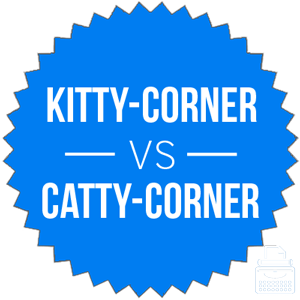When something is located diagonally from something else, what word would you use to describe this directional relationship?
You could, of course, just say located diagonally, but that isn’t much fun. English has two other phrases, kitty-corner and catty-corner, which mean the same thing but inject fun color into your writing to hold your reader’s interest.
Which version should you use? Does it matter? Read on to find out.
What is the Difference Between Kitty-corner and Catty-corner?
In this article, I will compare kitty-corner vs. catty-corner. I will outline the more common spelling and use it in example sentences, so you can see how it appears in context.
Plus, I will show you a helpful memory tool that makes choosing kitty-corner or catty-corner much easier.
When to Use Kitty-Corner
 What does kitty-corner mean? Kitty-corner can be an adjective or an adverb.
What does kitty-corner mean? Kitty-corner can be an adjective or an adverb.
To be kitty-corner to something is to be located on the diagonal from it. On a chess board, for example, the white squares are kitty-corner from each other, just like the black squares. Someone who is sitting one seat up and one seat over from someone else in the room is also kitty-corner.
Here are some example sentences that include kitty-corner,
- “I want Maria and Trea sitting kitty-corner from each other in the classroom so that they aren’t too close, but can still talk to each other if they need to,” said the second grade teacher.
- Kelly parked kitty-corner to a Lamborghini in the Wal-Mart parking lot, but when she was done shopping, the Lamborghini was gone.
When to Use Catty-Corner
 What does catty-corner mean? Catty-corner is a variant of the same phrase. It means the same thing and can be used in all of the same contexts.
What does catty-corner mean? Catty-corner is a variant of the same phrase. It means the same thing and can be used in all of the same contexts.
You could also replace kitty-corner with catty-corner in the previous section’s examples without changing their meanings.
This phrase itself originated in Middle English as catre corner, where it was related to a Latin term for four-cornered. The variant cater-corner is still in use today, though without the frequency of the other two forms.
This graph compares catty-corner vs. kitty-corner vs. cater-corner in English since 1800:

Kitty-corner and catty-corner are about even, with cater-corner lagging significantly behind. This chart isn’t exhaustive in its scope, however, since it only looks at books published in English since 1800.
Still, it gives a good impression of a long-term usage trend.
Trick to Remember the Difference
You could use either of these terms—they are interchangeable. You should base your decision on which seems most natural in your writing and what you expect your audience to find the least distracting.
Kitty-corner has an ever-so-slight advantage in usage, at least for now, so it might be the safer bet if you still can’t decide.
Since kitty-corner contains the letter I, you can say the phrase I will use kitty-corner in my writing to yourself as a reminder that kitty-corner is slightly more popular.
Summary
Is it catty-corner or kitty-corner? There are three variations of this phrase, all of which are interchangeable.
- Kitty-corner and catty-corner mean diagonally located.
- Cater-corner is a rare variant.
You could choose whichever version seems most natural to you, but kitty-corner has recently become the most popular.
Contents
